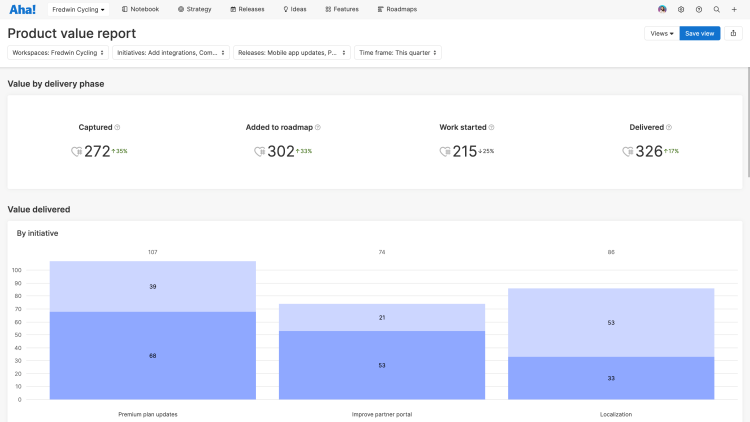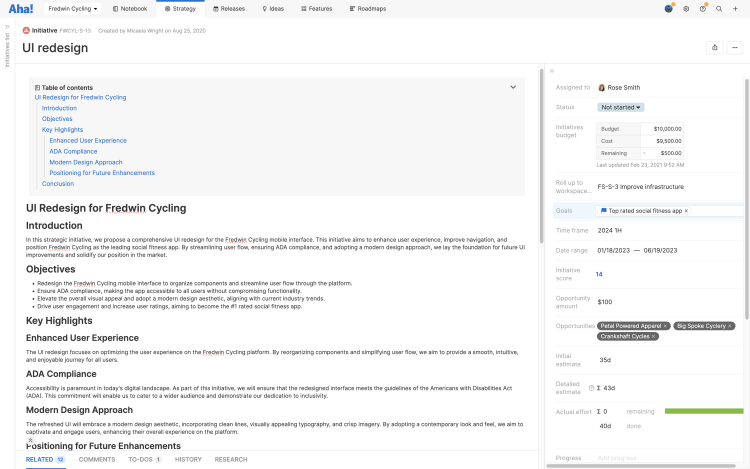This article is one of a six-part series on stakeholder alignment throughout the product development lifecycle.
Aha! Roadmaps | Best practices for stakeholder alignment: Set product strategy
Many internal groups have a stake in the success of your product — including executive leadership and cross-functional partners such as marketing, sales, and support. Each of these groups plays a vital role in serving your customers and driving business growth. This is why it is so important to establish a collaborative planning process that all of your key stakeholders can actively participate in. When everyone is on board with what you plan to deliver and why, your entire organization can move forward in sync and with purpose.
In this six-part series, we provide best practices on how to drive stakeholder alignment at every stage of the planning process. Each article highlights the best way to engage key stakeholders and the powerful tools that are available in Aha! Roadmaps to help you succeed.
Set product strategy
This article covers how to define the steps in your strategic planning process. First, identify who your key stakeholders are and how you will engage them along the way — setting clear expectations and building trust from the outset. The next step is to get clarity around your product strategy. This is foundational to the entire process because it maintains focus on the "why" behind your roadmap. Use this initial planning period to review recent progress, assess current market conditions, and align on business goals so you can home in on the high-level areas you want to invest in.
Click any of the following links to skip ahead:
Step 1: Establish a clear planning process
Bring a greater level of transparency to how the roadmap planning process works. Show the timeline for what will happen and when — working back from when you need to have your formal plan in place. For example, if your sales kickoff meeting happens in January each year, you might need to start your planning process in September or October to make sure your roadmap is ready in time. It is also important to think through who you need to involve along the way and create space in your plan for getting stakeholder buy-in.
Here are some whiteboard templates to help you with this upfront preparation:
Create a timeline diagram to show key steps in your process. Highlight important milestones — such as key planning meetings and deadlines.
Build a stakeholder map to identify who needs to be involved in the planning process and capture what is important to them.
Use the stakeholder analysis template to define each person's level of participation and the best way to engage them.
Being clear on who your key stakeholders are and the outcomes they care about from the beginning helps you get the planning process off to a positive start. Share your timeline with everyone involved to set expectations and convey when you will ask for input. This assures everyone that you value their contributions and the expertise they bring.

Step 2: Reflect on product performance
Now, it is time to start planning! It is important to look back at what you accomplished in the previous time frame before you decide what to work on next. Analyze your key success metrics to assess how you performed against your goals. And take a critical look at how effectively you delivered against your roadmap. What did you achieve, and where did you fall short? If you tracked progress along the way (which we hope is the case), there should be no significant surprises here. This step is about summarizing your learnings to inform how you move forward.
There are a number of reports you can refer to in Aha! Roadmaps to quickly gain the insights you need:
Create a pivot report of goals and success metrics for the last time frame.
Recognize what you accomplished with the product value report.
Review your previous roadmap to identify anything that was not completed.
Document your learnings and share them with executive leadership. This will help inform whether you need to stay the course or change direction to have a bigger impact. It is also worth noting any major roadmap items that the team was not able to complete. This helps you decide whether it makes sense to keep them on the roadmap or focus on new areas of functionality.

Step 3: Review business and market conditions
Identify any shifts in the market that are impacting your company and product. Executives will likely have insights into how the economic climate is affecting business performance, whereas other teams (such as marketing and sales) can share insights on the competitive landscape and what customers are saying.
Whiteboards are perfect for conducting this research. Choose from a variety of strategic models to organize your approach, and then share the whiteboard with others to get their perspectives. Collaborative tools such as sticky notes, inline comments, and emoji reactions make it easy for everyone to capture their thoughts and challenge core assumptions.
Here are some templates you can use to get started:
Use the PESTLE analysis or Porter's 5 forces templates to assess economic and market forces that are impacting your industry.
Conduct a competitive analysis to assess how you stack up against alternative solutions, noting any competitors that have entered or left the market.
Complete a SWOT analysis to evaluate the internal and external factors that could impact the success of your business or product
Review your high-level business model and product positioning to make sure your approach still makes sense.
Once you have aligned on the foundational elements that inform your product strategy, update your strategic models in Aha! Roadmaps. This makes them easy to reference as you set your product strategy.

Step 4: Set company and product goals
The next step is capturing your strategic goals. We recommend following a top-down approach, working with business leadership to understand your overarching company goals and set product goals that contribute directly to your organization's success.
Some of your product goals might not change between time frames. For example, you might have a core set of objectives to grow revenue, increase the number of users, or drive upsells. For these goals, it might only be the success metric that changes each time.
Other goals might be net-new. For example, you might need to expand into an additional region or launch a new product. Success metrics for these goals will be new as well, so make sure you get the clarity you need from leadership while you define your objectives.
Every company has its own process for setting objectives. What matters is that you get insights into how success will be measured and the time frame for achieving each goal. This grounds your roadmap — and everyone who influences it — in what you need to accomplish and why.

Step 5: Identify strategic initiatives
Now, it is time to start thinking about the key areas of your product — or key initiatives — that you want to invest in to achieve your goals. Some of these big themes might already be clear, but others could need more exploration. And your thinking might shift as you review customer feedback and gather ideas from stakeholders. With this in mind, it is important to keep an open mind and not rush to formalize your initiatives.
Whiteboards (once again) are the tool of choice for exploring these possibilities. Having a visual space to think through concepts, sketch out early plans, and exchange ideas is key to driving product innovation. Here are some suggestions to help you get going:
Add a simple table and use sticky notes to identify possible initiatives — jotting down key features that could go into each bucket.
Create a concept map or mind map to explore a potential theme of work and identify related ideas.
Use the strategic roadmap template to sketch out a high-level timeline for implementing major work efforts.
Share your early thoughts with product and company leaders and ask for their feedback. Depending on how people interact, you might do this 1:1, in a meeting, or even via your messaging application (if you are a smaller and super nimble team). This early collaboration is essential — without it, you will not gain the strategic alignment you need. Asking for feedback might also spark other insights that you did not consider and will help you distill your goals and initiatives into what will have the most positive impact for customers and the business.

Step 6: Document your product strategy
Once you have aligned on your product goals and initiatives for the next planning horizon, enter them into the Imperatives section of Aha! Roadmaps. Establish a link between each goal and its relevant initiatives to show how you will deliver the desired outcomes. This provides a solid foundation for what you want to accomplish — making your strategy transparent to the rest of the organization so you can rally everyone around your plans.
Even after you create your product roadmap, you should continue to revisit your goals and initiatives to make sure you are prioritizing the right work. This will keep your roadmap focused on the most impactful items as plans shift.

Now that you have a clear set of goals and initiatives, read the next article to review customer feedback and gather input from key stakeholders related to these areas — so you can identify the best ideas to achieve success. You can then use these insights to refine the definition of each initiative and prioritize what you want to work on.